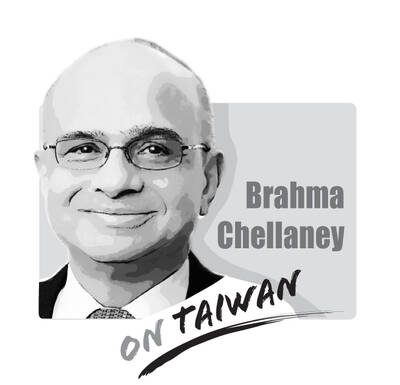With the rapid development of artificial intelligence (AI) technology, developing sovereign AI has become an important issue for many countries to protect their digital sovereignty.
A country needs to independently develop and control AI technology and infrastructure to avoid relying on foreign technology and ensure that their economy, culture and society are free from foreign influence.
With the rise of China’s AI capabilities, Taiwan must be prudent and develop its own sovereign AI to ensure national security and technological autonomy.
In Taiwan, although there is a Chinese-language version of OpenAI’s ChatGPT, using it comes with some problems.
Due to disparities in size, population and the amount of materials online between Taiwan and China, only a small proportion of data used to train ChatGPT’s Chinese-language AI model is from Taiwan.
As a result, the tone, terms and cultural background of ChatGPT’s Chinese-language AI model are more like the language used in China.
For example, for the word meaning “lean,” ChatGPT’s Chinese-language version uses the word used in China, “jingyi” (精益), rather than the word used in Taiwan, “jingshi” (精實).
For “digital transformation,” it uses China’s “shuzi zhuanxing” (數字轉型), rather than Taiwan’s “shuweizhuanxing” (數位轉型).
For “sustainable development,” it uses China’s “kechixu fazhan” (可持續發展), rather than Taiwan’s “yongxu fazhan” (永續發展).
For “through,” it uses China’s “tongguo” (通過), rather than Taiwan’s “xiuguo” (透過).
These subtle differences could gradually influence the language spoken in Taiwan, which could eventually shape people’s views and cultural preferences.
China has developed its own AI in recent years, launching large language models (LLMs) such as Ernie Bot (文心一言).
If Taiwanese begin using such products on a large scale, China would not only be able to shape their thinking patterns, but also influence Taiwan’s society, culture and values.
Such cultural infiltration would pose a threat to the nation’s digital sovereignty and likely damage its democratic resilience.
To defend its digital sovereignty, Taiwan must begin developing its own AI technology and infrastructure. The Trustworthy AI Dialogue Engine (TAIDE) led by the National Science and Technology Council is an important start.
Based on Meta’s open-source language model Llama 3, TAIDE is trained with traditional Chinese language data, giving TAIDE local language advantages when processing Traditional Chinese conversations.
Through this move, Taiwan can avoid the erosion of its language and culture by foreign technologies and provide AI services more in line with local needs.
However, there are still deficiencies with the model training data and scale of TAIDE. More localized data is needed to improve its understanding and communication capabilities.
Many countries are developing their own sovereign AI, including France and the UK, which have invested resources into developing AI that reflects their language and culture.
France’s Mistral AI and the UK’s BritGPT are typical examples. Likewise, Singapore is partnering with Nvidia Corp to develop the SEA-LION LLM model specifically designed for Southeast Asian languages and cultures, demonstrating the importance of sovereign AI.
The role of government cannot be ignored. Government can lead the development of AI through the digitization of public services. Singapore’s Pair project, which uses generative AI to reduce the workload of civil servants and ensure data security, is a successful case that Taiwan can learn from.
Taiwan should boldly experiment with and implement AI technology to improve the efficiency of its public services and aid the development of the TAIDE.
This would help the nation maintain its autonomy and resist the impact of foreign technologies on its culture and society.
Liao Ming-hui is an assistant researcher at the Chung-Hua Institution for Economic Research.
Translated by Lin Lee-kai

Taiwan stands at the epicenter of a seismic shift that will determine the Indo-Pacific’s future security architecture. Whether deterrence prevails or collapses will reverberate far beyond the Taiwan Strait, fundamentally reshaping global power dynamics. The stakes could not be higher. Today, Taipei confronts an unprecedented convergence of threats from an increasingly muscular China that has intensified its multidimensional pressure campaign. Beijing’s strategy is comprehensive: military intimidation, diplomatic isolation, economic coercion, and sophisticated influence operations designed to fracture Taiwan’s democratic society from within. This challenge is magnified by Taiwan’s internal political divisions, which extend to fundamental questions about the island’s identity and future
Media said that several pan-blue figures — among them former Chinese Nationalist Party (KMT) chairwoman Hung Hsiu-chu (洪秀柱), former KMT legislator Lee De-wei (李德維), former KMT Central Committee member Vincent Hsu (徐正文), New Party Chairman Wu Cheng-tien (吳成典), former New Party legislator Chou chuan (周荃) and New Party Deputy Secretary-General You Chih-pin (游智彬) — yesterday attended the Chinese Communist Party’s (CCP) military parade commemorating the 80th anniversary of the end of World War II. China’s Xinhua news agency reported that foreign leaders were present alongside Chinese President Xi Jinping (習近平), such as Russian President Vladimir Putin, North Korean leader Kim
Taiwan People’s Party (TPP) Chairman Huang Kuo-chang (黃國昌) is expected to be summoned by the Taipei City Police Department after a rally in Taipei on Saturday last week resulted in injuries to eight police officers. The Ministry of the Interior on Sunday said that police had collected evidence of obstruction of public officials and coercion by an estimated 1,000 “disorderly” demonstrators. The rally — led by Huang to mark one year since a raid by Taipei prosecutors on then-TPP chairman and former Taipei mayor Ko Wen-je (柯文哲) — might have contravened the Assembly and Parade Act (集會遊行法), as the organizers had
Minister of Foreign Affairs Lin Chia-lung (林佳龍) last week made a rare visit to the Philippines, which not only deepened bilateral economic ties, but also signaled a diplomatic breakthrough in the face of growing tensions with China. Lin’s trip marks the second-known visit by a Taiwanese foreign minister since Manila and Beijing established diplomatic ties in 1975; then-minister Chang Hsiao-yen (章孝嚴) took a “vacation” in the Philippines in 1997. As Taiwan is one of the Philippines’ top 10 economic partners, Lin visited Manila and other cities to promote the Taiwan-Philippines Economic Corridor, with an eye to connecting it with the Luzon